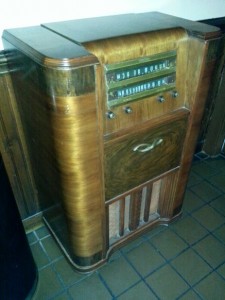News and Observer reporter John Murawski wrote today of a group of electricity customers who fear that the smart meter Duke Energy uses is poisoning them with radio-frequency (RF) radiation.
Andrew McAfee of Raleigh submitted a 45-page filing, noting prominently: “Sent from a cabled computer with the WiFi turned off.”
“Your body basically becomes an antenna,” he said from his landline phone last week. “I immediately feel a tingling, burning sensation on my scalp.”
“These meters are designed to burst a radiation signal out a couple of miles,” McAfee said of smart meters. “Imagine every house in your neighborhood blipping out these things all day.”
Apparently, people don’t understand that radiation of the RF variety is not the same as radiation of the nuclear variety. One is a known carcinogen. The other brings you Fox News (whether Fox News is a carcinogen is post for another day).
Blaming RF (which I’ll call by their better-known name, radio) for something is akin to blaming sound: it all depends on what the sound or radio is. Listening to music with your ear placed on the grill of a 1000 watt audio amplifier will likely cause you injury, whereas the same music at a reasonable volume on your stereo at home can be safe and enjoyable.
Radio exhibits an amazing variety of properties as its frequency changes. Very low frequency (VLF) signals penetrate the deepest recesses of the ocean, bringing information to submarines but are very slow to modulate (add information to). Very high frequencies (VHF) can be blocked by raindrops (think radar) but can modulate an enormous amount of information. The frequencies used by FM radio easily penetrate homes but the 5 GHz used by your indoor wireless phones do not.
Then there is the power behind the radio waves: how strong is it? Like sound waves, radio waves decrease exponentially with distance. The closer you are to a transmitter the more radio energy you absorb.
Are there dangers to radio? Absolutely. Everyone is familiar with what a one-kilowatt microwave transmitter can do to heat up one’s lunch. Generally, though, the products we use everyday have been tested and measured and are safe to use.
Earlier this year I found this gem. Wake County Public Schools’s Adult Evening Education catalog listed this one-day class that took place on Monday. I was sorry I missed attending because I wanted to see what was said. I am also surprised that the Wake County School System was keen to turn over its classrooms after-hours to such questionable science.
Dangers of Electromagnetic Pollution in the Home
Do fluorescent lights give you a headache? Do you feel dizzy or tired when carrying around your cell phone? You may have an electromagnetic pollution sensitivity. Our bodies are more than flesh and blood. They respond to and are impacted by the electrical fields emitted in our technological culture. This class offers an indepth look into the electromagnetic pollution created by today’s electronic gadgets. Learn the dangers to your health and what you can do to protect yourself.
So, this has me curious. Electronic ballasts make modern fluorescent lights flicker in the 10-20 kilohertz range, a rate that’s orders of magnitude beyond what the human eye can possibly perceive. As far as cellphones go, I know of no studies that show cellphone radiation causes dizziness. Cellphones have been shown to make people tired, but not simply by carrying them (ok, if you’ve got an ancient brick cell phone, perhaps) but because the blue-wavelength light in their displays prevents the brain from manufacturing the sleep-inducing hormone, melatonin.
Microwave radiation from cellphones and other devices does have the potential for heating your brain if placed in close enough proximity. That’s what microwaves do, of course. Will it kill you? Well, no one’s proven this yet. So, it’s prudent not to expose oneself to more RF than necessary and the training I received suggests always using the lowest power. While it might be prudent to limit mobile phone (or use a headset), there’s no reason to stop using a mobile phone and there’s certainly nothing to fear from a box hanging outside of your home that transmits occasionally using short, low-power bursts.
I’ve been trained in radio in the military and also as an amateur radio operator. I take RF exposure seriously but not to the point of avoiding technology. It is impossible in modern society to avoid radio waves. There is not one spot on Earth that radio hasn’t touched. The key is to know what it can and can’t do and not simply rely on rumor.
